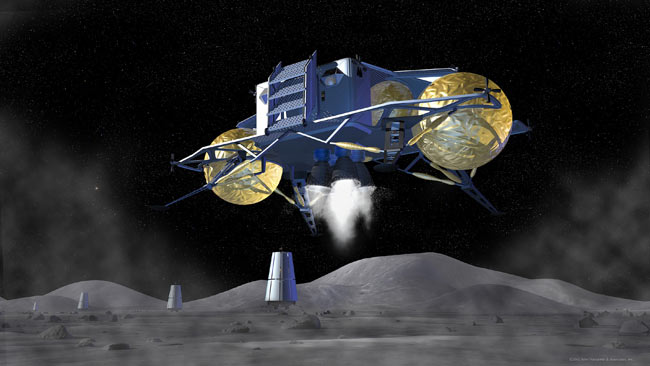Newt Gingrich's Moon Base by 2020: Can It Be Done?

GOP presidential primary candidate Newt Gingrich has promised a manned moon base by 2020 if he is elected, yet such a plan will face some serious budgetary and practical hurdles, experts say.
Gingrich is in Florida competing for that state's nomination for the Republican candidacy against Mitt Romney, Ron Paul and Rick Santorum. Ambitious plans for America's space program are likely to generate enthusiasm among those in Florida's space industry, hard-hit by the retirement of the space shuttle last year.
"By the end of my second term, we will have the first permanent base on the moon, and it will be American," Gingrich promised during a speech in the city of Cocoa, on Florida's Space Coast, Jan. 25.
Yet experts question whether a plan to send people to live on the moon can so quickly be achieved. [50 Years of Presidential Space Visions]
For one thing, the United States does not currently posses a vehicle capable of flying to the moon.
"When we are not expecting a U.S. crewed launch to the [International Space Station] until 2016-2017 and are just getting started on a lunar-class launch vehicle, establishing a lunar outpost by 2020 is a fantasy," space-policy expert John Logsdon, professor emeritus at George Washington University, told SPACE.com in an email.
Furthermore, experts question whether the country has sufficient motivation for such a trip.
Get the Space.com Newsletter
Breaking space news, the latest updates on rocket launches, skywatching events and more!
"Without either economic justification or national security concerns to sustain such grand activities, I do not envision a confluence of support from the various political, social, and economic interests in the United States for a significant expenditure of national effort, human capital, and treasure to undertake a human mission to return to the moon," Roger Launius, space history senior curator at the Smithsonian National Air and Space Museum in Washington, D.C., wrote in an email. "I would like to be proven wrong because I would dearly love to see humans on the moon again in my lifetime, but I must question whether or not a sufficiently compelling reason for humans to return to the moon will emerge in the near term."
Gingrich didn't elaborate on how much his vision for the future would cost. But a 2009 independent analysis by the Center for Strategic and International Studies, a foreign policy think tank, estimated that establishing a manned international lunar base would cost about $35 billion, with an additional price tag of $7.35 billion per year to keep the base operating.
These tallies do not include the costs of designing and building the heavy-lift rocket and crew capsule required to make the journey to the moon.
"All supplies (O2, H2, food, etc.) would be supplied from Earth and recycled to the maximum extent possible," according to the Center for Strategic and International Studies report. "If useable water ice is found near the base, or oxygen-rich minerals can be utilized, operating costs will decrease significantly."
Yet Gingrich also said that, if elected, he would slim down NASA's bureaucracy, reduce the agency's budget and devote 10 percent of its funds to prizes aimed at spurring commercial investment in space exploration.
Staff writer Denise Chow (@denisechow) contributed to this story. You can follow assistant managing editor Clara Moskowitz on Twitter @ClaraMoskowitz. Follow SPACE.com for the latest in space science and exploration news on Twitter @Spacedotcom and on Facebook.
Join our Space Forums to keep talking space on the latest missions, night sky and more! And if you have a news tip, correction or comment, let us know at: community@space.com.

Clara Moskowitz is a science and space writer who joined the Space.com team in 2008 and served as Assistant Managing Editor from 2011 to 2013. Clara has a bachelor's degree in astronomy and physics from Wesleyan University, and a graduate certificate in science writing from the University of California, Santa Cruz. She covers everything from astronomy to human spaceflight and once aced a NASTAR suborbital spaceflight training program for space missions. Clara is currently Associate Editor of Scientific American. To see her latest project is, follow Clara on Twitter.









